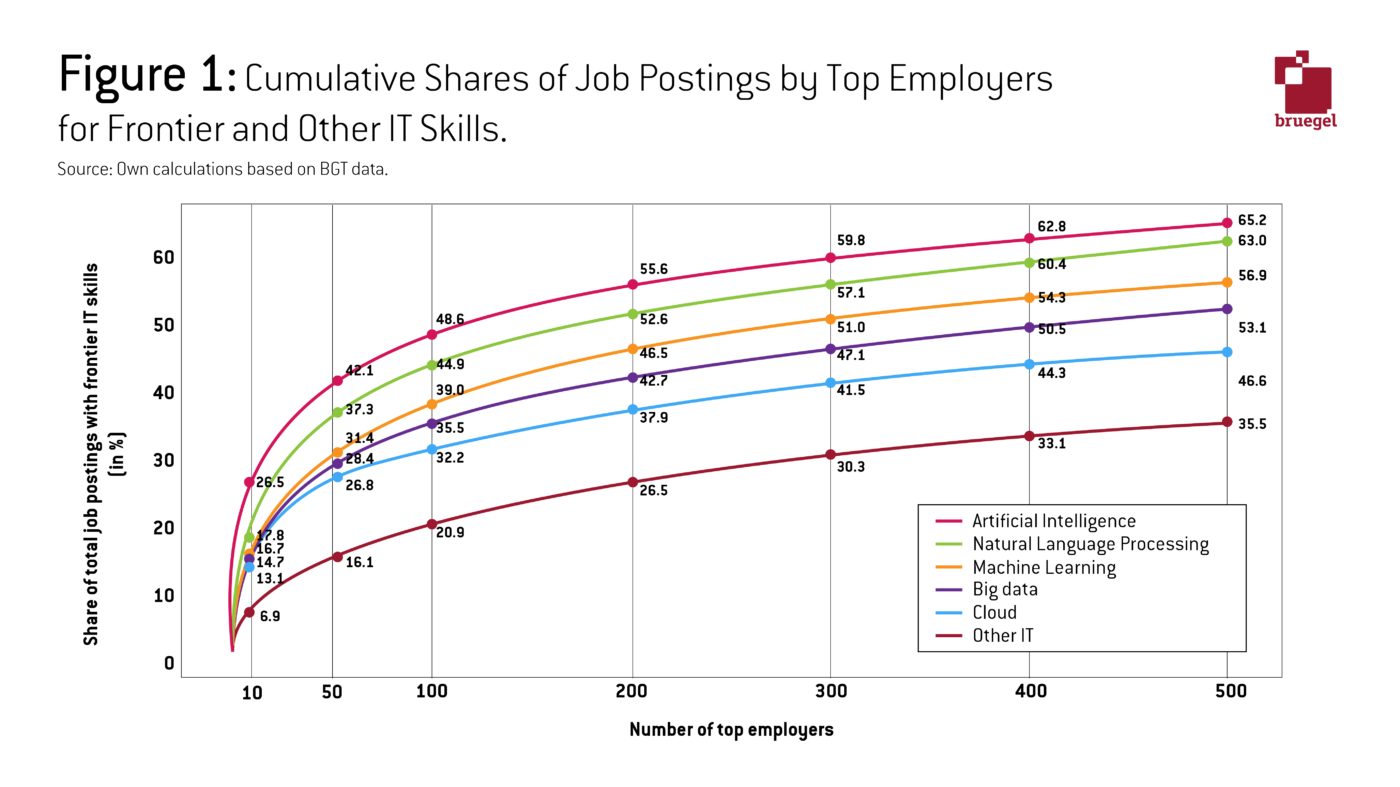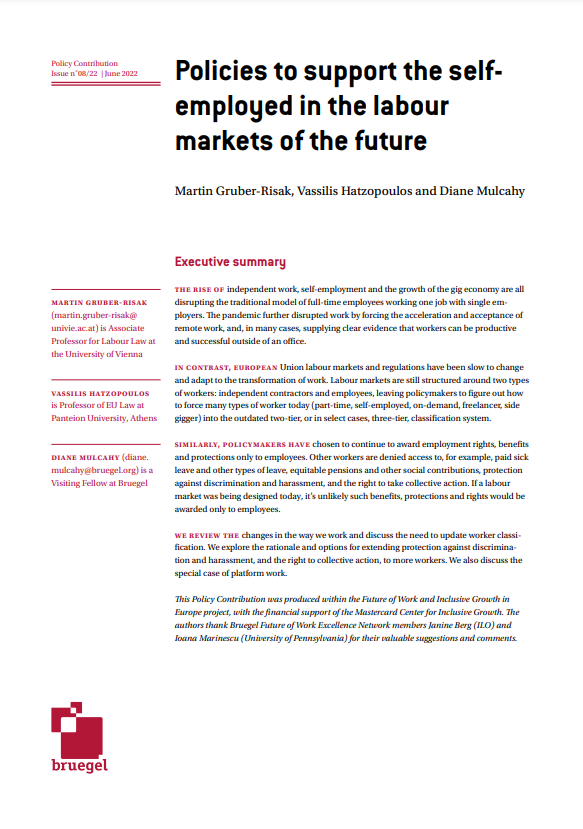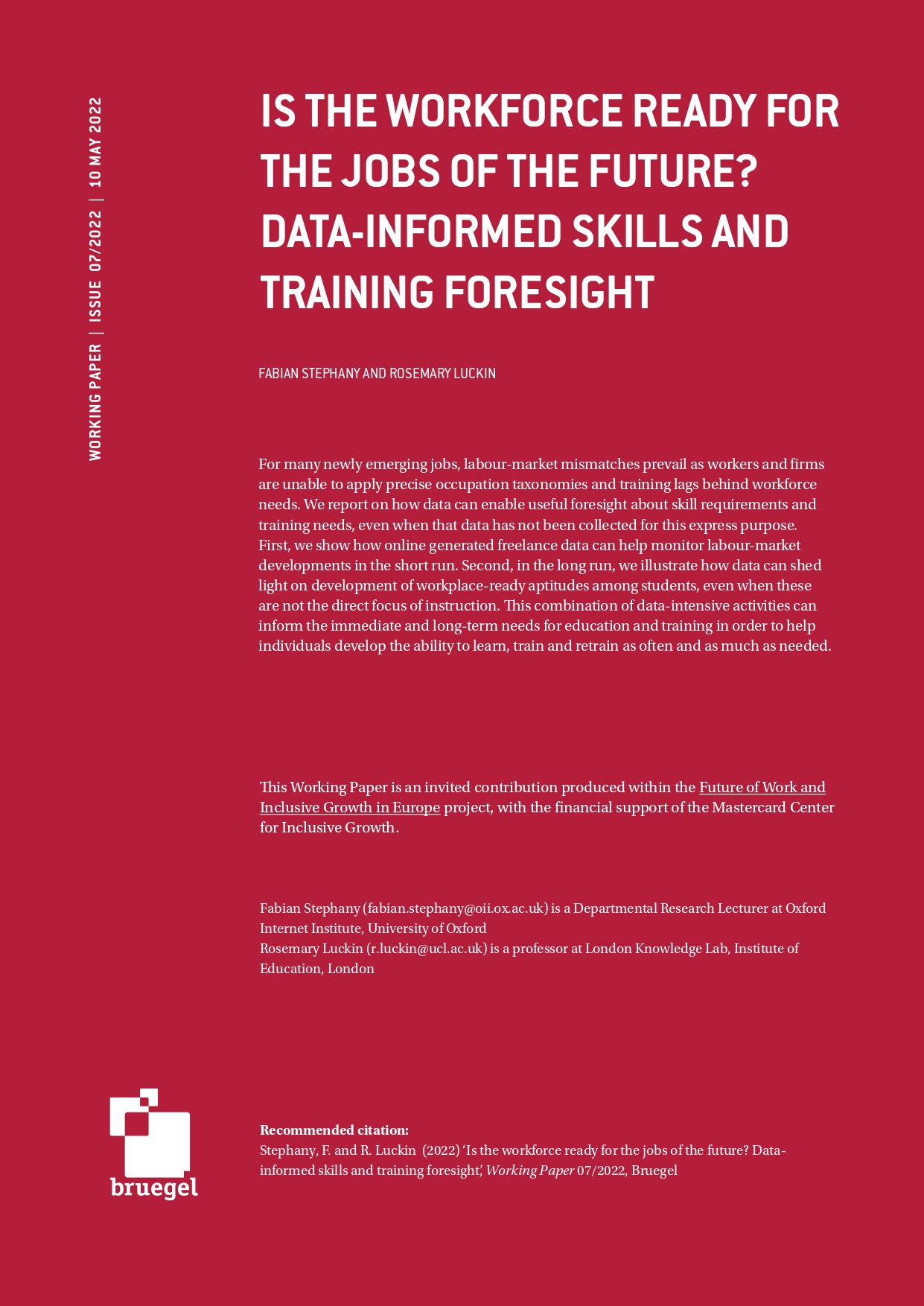Blog Post
Concentration of artificial intelligence and other frontier IT skills
Online job postings indicate that demand from top tech firms for frontier IT skills is about double their demand for other IT skills. This could indicate increasing concentration of skills in a few firms, with other firms left behind.
Revolutionary digital technologies including artificial intelligence (AI) and machine learning (ML) are associated with significant efficiency gains that can increase social welfare and lead to a productivity boom. One way to assess how widely these technologies are adopted and spread across firms is to measure the degree of concentration of demand from firms for frontier IT skills associated with these technologies. High concentration of frontier IT skills in the hands of a few firms can prevent other firms from harnessing the benefits of digital technologies, thereby restricting the social gains from AI and ML. In this blog post, we present some preliminary results on the concentration among firms of frontier IT skills related to new digital technologies and make recommendations on how policy can work to increase the associated social benefits.
Optimistic predictions expect frontier IT skills and technologies to lead to a productivity boom post-COVID-19 by advancing the economy in a productivity J-curve pattern. The curve describes the historical pattern of productivity growth after the introduction of a breakthrough technology such as AI: productivity initially grows slowly, and may even decrease for a prolonged period of time, before significant productivity increases are realised.
Breakthrough technologies, or general purpose technologies, can have a significant impact on our economy and society but require substantial complementary (usually firm-specific) investments in intangible capital and fundamental restructuring of organisational capital, in order to take full advantage and reap the productivity benefits of these new technologies. Firms need to rethink entire business models, managers need to develop expertise for the digital age, workers need to be adequately (re-)trained and complementary software needs to be designed. In principle, this adoption and adaptation process can take years, even decades, before the benefits translate into productivity statistics – as was the case with the steam engine, electricity, the internal combustion engine and computers. So, overall, there are two different phases in the impact of new general purpose technologies on total factor productivity growth: a phase during which complementary innovations and intangible capital are accumulated and only modest productivity growth is observed, followed by a phase of booming productivity.
Crises often lead to increased innovation and technology adoption. During the COVID-19 pandemic, work and production have undergone major changes as firms have been forced to reorganise their businesses by embracing remote work and digital technologies. As a result, a decade’s worth of digital innovation has been compressed into just under two years, leading us closer and faster to the take-off point of the J-curve.
However, the diffusion of the benefits from this take-off throughout society and the entire economy depends on the degree of concentration in the adoption of these technologies and complementary skills. Widespread adoption by firms of AI and related IT skills can decisively contribute to higher social welfare that is evenly distributed among producers, consumers and workers.
If AI technology adoption is instead concentrated in the hands of few firms, the benefits for the whole economy will be limited. Of particular concern is whether top firms, by snapping up frontier talent, prevent other firms (especially start-ups and small firms) from realising the importance of these skills for productivity and from implementing them in effective ways. The adoption of frontier IT skills also brings its own learning curve. As firms adopt more AI and ML skills, they also gradually learn how to integrate them into their business structures in order to become more productive and more valuable to their customers. If these skills are highly concentrated and therefore unavailable for wide adoption, small and medium-sized firms will miss the opportunity to learn how to apply these skills.
Preliminary results
Using US online job posting data from Burning Glass Technologies (BGT) from January 2010 to June 2020, we find that the top employers account for a large percentage of the total demand for frontier technology skills, including AI, ML, natural language processing (NLP), cloud computing and big data. More than 26% of all job vacancies in the last decade that required AI skills were posted by the top 10 firms that employed people with AI skills (Figure 1). Similarly, approximately, 18% of ML, 17% of NLP, 15% of cloud computing and 13% of big data job vacancies came from the top 10 firms that employed those skills. In comparison, the share of these firms’ postings for all other IT skills (ability to work with Microsoft Office, or to manage information systems) sat at just 7%. Even beyond the top 10, we find the same pattern: the demand share of the top 50 or 100 firms for frontier IT skills is still about twice as large as their demand for other IT skills.

The top 10 employers for each of the frontier IT categories (by number of job postings that are relevant to frontier IT skills) in many cases coincide. Typical employers with high demand for these skills are: Amazon, IBM, Microsoft, Apple, Accenture, Deloitte, Facebook, JP Morgan Chase, Capital One and Salesforce. These firms tend to hire not only those with more IT skills but also those with specialist frontier skills. IT skills make up at least a third of all skills demanded by the top firms, while these skills only reach on average a quarter for mid-tier and less than a fifth for low-tier firms (Figure 2).

With an increasingly digitalised labour market, a larger share of labour and skill demand is captured by the online job market, especially for frontier skills. This digital transformation of the labour market has made very detailed worker-level information available, especially for highly skilled workers. LinkedIn has more than 740 million active users with an online profile. This easily accessible information on skills significantly reduces the costs of recruiting and poaching, disproportionately benefiting superstar firms with superior human resources teams and headhunting capabilities.
These top employers are also more prestigious and have the cash holdings to provide higher pay and better benefits, which high-quality workers seek, especially in their early careers. Many superstar firms, including Google, Amazon, Apple and Microsoft, engage in headhunting to acquire the top talent they need. Small and medium-sized enterprises and start-ups are unable to compete as they cannot match these wages or benefits. To further tilt the balance, these large firms are now increasingly cooperating with, and funding, universities and research institutions, allowing the firms to identify and target talent much earlier. This ‘brain drain’ exacerbates the gap in skill acquisition further.
Another way for superstar firms to acquire talent is through mergers and acquisitions (M&A). Over the past decades, superstars have aggressively used their large cash holdings to acquire small but strategic firms to gain access to technology patents and talent, or both. Figure 3 presents the percentage of M&A deals by Google, Amazon, Facebook, Apple and Microsoft that incorporated a talent acquisition.
Amazon and Microsoft acquired talent in more than 60% and 50% of their M&A deals respectively. Google and Apple acquired talent in more than 80% of their deals, while Facebook tended to acquire talent through its acquisitions at a rate of more than 92%. These big tech firms were involved in at least 850 M&As in the past two decades, with most taking place since 2010.
Social and welfare implications
As frontier IT skills become increasingly crucial to compete in today’s markets, it is important to better assess the implications of their concentration on social welfare, innovation and productivity, with corrective measures where needed.
There are several policy options to consider. Labour-market concentration should be examined in antitrust investigations, particularly in M&A cases, as US Federal Trade Commission Chair Lina Khan recently urged the US Congress to do, with an emphasis on potentially dynamic effects on innovation. Policies should also aim to provide extra incentives for innovation in order to make these skills more easily accessible and applicable for workers and firms.
Moreover, increasing the supply of frontier IT and complementary skills through education and training programmes will be critical, especially in jurisdictions and for firms that have been left behind. The US has the best AI education and training opportunities and the largest supply of AI talent, according to LinkedIn’s Economic Graph, while in the EU there is a considerable AI skills shortage, in part due to more AI scepticism.
In addition, well-targeted programmes should be adopted in order to increase the incentives for small and medium enterprises to innovate and adopt frontier IT skills. These programmes should particularly aim at reducing the learning costs for these enterprises. There is a wide range of instruments to consider, from tax credits to firm-based free AI training programmes that can help firms learn faster at a minimum cost.
Facilitating better uptake and spread of AI and other frontier IT technologies can have many social benefits and can enable an all-inclusive productivity boom to arrive sooner.
Recommended citation:
Wang, J., G. Petropoulos, and S. Steffen (2021) ‘Concentration of artificial intelligence and other frontier IT skills’, Bruegel Blog, 21 October
Republishing and referencing
Bruegel considers itself a public good and takes no institutional standpoint. Anyone is free to republish and/or quote this post without prior consent. Please provide a full reference, clearly stating Bruegel and the relevant author as the source, and include a prominent hyperlink to the original post.







